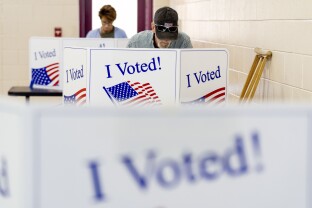Democrats are hoping to tap into every advantage that they didn’t have last time they had to run against Donald Trump, including that they’re not running in a global pandemic.
They just aren’t sure exactly how much difference an infinitely more robust ground game will make.
Kamala Harris’ campaign and an array of liberal groups have built a massive door-to-door canvassing operation, the kind of comprehensive voter-outreach effort they were unable to do in 2020. They hope it can help the party turn out voters — many of them in cities and dismissive of any political communication other than a face-to-face conversation — who didn’t come out to vote four years ago.
“Everything fell short in 2020,” said Joan Kato, a veteran Democratic field organizer. “Nobody was able to register voters as they thought. Nobody was able to knock on as many doors as they wanted. We weren’t able to reach as many communities that needed extra hand-holding and that extra touch to remind them to vote.”
Being able to do so in 2024, she said, could add tens of thousands of votes to Harris’ total in key states.
Some political operatives, including Democrats, are skeptical the difference will be that large. There was a historically high turnout in 2020, they point out, and they doubt that even an effective field operation ultimately moves that many voters. The left’s ground game might be important this year, they say, but liberals hopeful that there was an untapped pool of voters in the last election are likely going to be disappointed.
But in a race expected to be extremely close, veteran field organizers say every possible advantage counts.
“We think, when you’re in this super close election, and I think it’ll be closer than it was in 2016 or 2020 in Nevada, we think it absolutely makes the difference,” said Ted Pappageorge, secretary treasurer of the Culinary Workers Union Local 226, which runs the largest field program in the state and forms the backbone of Democratic efforts there.
The debate over whether Democrats’ field program can turn out an extra tranche of voters in November really began after the 2020 election, when some party operatives blamed the weakened ground game for tighter-than-expected results. Officials with the Texas Democratic Party, for instance, highlighted it as a primary reason its candidates didn’t fare better that year.
Democrats largely gave up on door-to-door canvassing in 2020 because of concerns that in-person politicking risked spreading COVID-19. And even if campaigns were convinced they could do so safely, many voters might feel differently and be turned off by any outreach.
“It wasn’t anywhere near what our expectation would be of a robust field program,” said Steve Smith, spokesperson for the AFL-CIO. “There were pockets of good field programs, but it was really hard. You don’t want to put anybody’s health at risk.”
Democrats have no such qualms this year, saying they have already built the kind of comprehensive field program to match or exceed prepandemic efforts. In Wisconsin alone, a Harris aide says the campaign has opened 48 offices in 43 counties, backed by 200 staff with the coordinated campaign.
Democratic field programs have traditionally been most effective in cities, organizers say, where population density makes walking door-to-door easier and where large concentrations of the party’s voters live. That’s where Democrats think they suffered the most in 2020, with many solid party supporters failing to turn out and helping Trump make surprising gains relative to 2016 in places like Philadelphia and Detroit. (Many of these Democrats also caution that field programs weren’t the only reason Trump did better in cities during the last election, citing his improved standing among some Black voters.)
Many urban voters were “not being really reached” by Democrats’ digital campaigns in 2020, said Michael Podhorzer, a veteran Democratic strategist and former political director for the AFL-CIO. “That’s where door-to-door canvassing comes in because it creates buzz in the community.”
Given that he and most others expect the election to be decided by a half-point or less in many swing states, he added, that extra boost could be decisive.
Other progressives agreed.
“I do think the inability to run the same type of field operations that we historically have in all those communities was one of several factors in the modest underperformance in those places,” Greg Speed, the president of America Votes, said.
Speed remembers feeling distressed days before the 2020 presidential election, when he started receiving reports that voters in Philadelphia — most of them likely to vote Democratic — still didn’t know where to cast their ballots. Unable to do traditional canvassing, he was convinced Democrats were leaving votes on the table.
“It affected a lot of precincts,” he said. “Not the whole city. But a lot of precincts.”
Democrats are buoyed by their experience during Georgia’s runoff race after the 2020 election when the party won a pair of Senate races after reinstituting a field program (both Jon Ossoff and Raphael Warnock exceeded their vote share in January’s race compared to the November results). In August of 2020, the Culinary Union also restarted its canvassing effort in Nevada, Pappageorge said, a campaign he credited with helping push Joe Biden to victory.
And Republicans did, by and large, run a canvassing operation in 2020, enabled by a greater confidence they could do so safely and by an electoral base less concerned in general about the virus. Erasing that advantage this year could pay dividends, Democratic strategists say.
“A really good, robust field operation is only going to end up getting you a point to three points more in support,” said Chuck Rocha, a Democratic strategist. “But in an election that’s only going to be close, that’s a massive advantage to have back in our arsenal of tools compared to 2020.”
Rocha and other Democrats cautioned, however, that field programs have become more difficult to run in recent years as some voters in battleground states grow weary of the deluge of political staffers showing up at the door every two years. Still, other strategists say that so many people voted in the 2020 election, which saw the highest turnout in decades, that they’re unsure there were that many more votes for the party to try to get.
“It took less to convince people to vote for Joe Biden,” said one veteran field organizer, granted anonymity to speak candidly. “Things were so dire that you didn’t have to do anything to convince people to vote.”
But if overall turnout does drop this year compared to the last election, they say that Harris’ field organizing efforts could once again prove crucial.
—
Alex Roarty is a reporter at NOTUS.
Sign in
Log into your free account with your email. Don’t have one?
Check your email for a one-time code.
We sent a 4-digit code to . Enter the pin to confirm your account.
New code will be available in 1:00
Let’s try this again.
We encountered an error with the passcode sent to . Please reenter your email.


